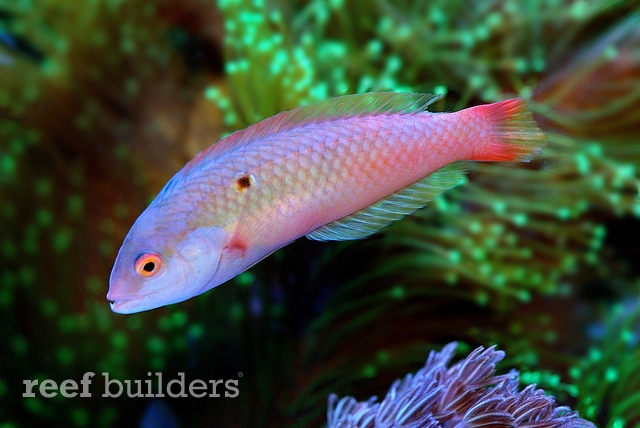Today’s Awesome Fish Spotlight goes to an unorthodox wrasse member from the genus Novaculops. Novaculops is a member of Novaculinae, which includes six genera of sand dwelling wrasses. The largest genus is Xyrichthys, but perhaps the most well known species from this group comes from the genus Novaculichthys, with N. taeniourus being the notoriously mischievous dragon or rock moving wrasse. All species are masters of their trade, which includes a lifestyle heavily dependent on soft sand.

The Novaculines are some of the most evolved and specialised of the labrids, and are very adept at manoeuvring in soft substrata. Many species are found in either seagrass or open sand habitats, away from reefs where they spend most of their lives. Their highly compressed body have evolved to suit their sand diving habits, for which they are notoriously good at. Also known as razor or cleaver wrasses for their laterally compressed bodies, these fishes are capable of disappearing almost instantly into sand.
While Halichoeres and other genera are also capable of burrowing, Novaculines are able to swim for short distances while under. To escape from predators, these razor wrasses are able to quickly dive into the sand and move respectable distances while under it. In order to do so, they vibrate their bodies in a buzzing fashion to dislodge sand particles as they move around in it.

The fish featured here is a member of this group, coming from the genus Novaculops. N. halsteadi is a wide ranging species that inhabits open rubble channels or wide sandy slopes well away from reefs. It range from Northern Indonesia to Japan, as well as the Coral Sea. They can also be found in Vanuatu and surrounding islands, where this individual came from. You might have recognised this fish from an earlier article featuring Mr. Wing’s tank from Hong Kong. Indeed it is the same individual, but because this fish is so awesome we decided to feature it on its own.
As with the prior description of their habits and nature, N. halsteadi would ideally require a soft sandy substrate for burrowing in when threatened or to sleep. The species can be maintained in bare bottom systems, provided a tray or container of sand is provided for the same purpose. This can be applied similar species with the same requirements from the genera Coris, Pseudocoris, Halichoeres, Macropharyngodon, Anampses, Pseudojuloides, all Novaculines as well as a couple of others.

Shown here is a purple male with the characteristic black spot behind the head. Females are white overall with a single brown stripe running down the dorsal region. In the wild and in aquariums, they can be maintained in small groups of multiple females and a single male. Although beautiful and wide ranging, this fish is not often targeted for collection because of the habitats they prefer and the lack of general interest in sand wrasses. A few specimens have been collected in the past, usually out of Australia or Vanuatu.
Novaulops halsteadi, like all Novaculines, have large jaws with strong teeth capable of crushing shelled invertebrates which they hunt from the sand or rubble. As such they are semi-reef safe and if you are intending to keep one, should not be housed with small invertebrates. They are also capable of eating small fish, and anything short of sly and cryptic may end up on the menu if it is hungry and underfed. That being said, if you have a suitable tank with suitable tank mates, do not let this deter you from having a go at this absolutely beautiful and unusual species.



